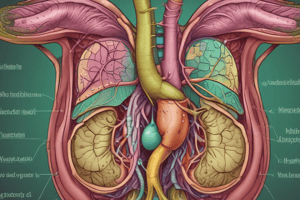Podcast
Questions and Answers
What are the three main parts of the gallbladder?
What are the three main parts of the gallbladder?
Neck, Body, Fundus
The gallbladder holds approximately _____ ml of bile.
The gallbladder holds approximately _____ ml of bile.
50
Which of the following is not a primary function of the gallbladder?
Which of the following is not a primary function of the gallbladder?
- Concentrates and stores bile
- Transportation of bile from liver to intestine
- Secretes digestive enzymes (correct)
- Stimulated by Cholecystokinin
The common bile duct can enlarge by 1 mm for each decade of life.
The common bile duct can enlarge by 1 mm for each decade of life.
What is the purpose of Heister's Valve in the gallbladder?
What is the purpose of Heister's Valve in the gallbladder?
What structure drains the cystic vein?
What structure drains the cystic vein?
Where is the gallbladder located in the body?
Where is the gallbladder located in the body?
The inner layer of the gallbladder wall contains _____ folds.
The inner layer of the gallbladder wall contains _____ folds.
Which ducts are involved in the biliary system?
Which ducts are involved in the biliary system?
What happens during a cholecystectomy?
What happens during a cholecystectomy?
What does the gallbladder primarily secrete from the liver?
What does the gallbladder primarily secrete from the liver?
Study Notes
Gallbladder and Biliary System Anatomy
- The gallbladder is a pear-shaped or thumb-shaped organ located inferiorly to the liver.
- The gallbladder is divided into the neck, body, and fundus.
- The fundus is the anterior portion of the gallbladder.
- The neck is the posterior portion, where Heister's Valve is located to prevent kinking.
- The gallbladder measures 2.5-4 cm in the anteroposterior diameter and 7-10 cm in length.
- The wall of the gallbladder is typically less than 3mm thick.
- The gallbladder holds approximately 50 ml of bile.
- The gallbladder's location can be identified using the following landmarks:
- The Main Lobar Fissure (MLF)
- The Portal Vein (PV)
- The Main Hepatic Vein (MHV)
Anatomical Variations of the Gallbladder
- Hartmann's Pouch: An outpouching near the neck of the gallbladder. It is a common location for stones to get stuck.
- Phrygian Cap: A folding of the gallbladder fundus.
- Junctional Fold: A fold at the neck of the gallbladder.
- Partial or Full Septation: A potential for a double gallbladder.
Biliary Duct Anatomy
- The biliary duct system consists of two main portions:
- Intrahepatic
- Extrahepatic
Intrahepatic Biliary Ducts
- Part of the portal triads.
- Right and Left Main Intrahepatic ducts.
Extrahepatic Biliary Ducts
- Cystic Duct: Continuation of the gallbladder neck. Connects the neck of the gallbladder to the Common Hepatic Duct.
- Common Hepatic Duct (CHD): Measures approximately 4 mm in diameter.
- Common Bile Duct (CBD): Measures up to 6 mm in diameter. The diameter increases 1 mm for each decade of life.
- The CBD passes through the head of the pancreas and joins with the pancreatic duct, forming the Ampulla of Vater.
- The Ampulla of Vater enters the duodenum, controlled by the Sphincter of Oddi.
Gallbladder Vascular Supply
- Cystic Artery: A branch of the right hepatic artery.
- Cystic Vein: Drains into the portal vein.
Layers of the Gallbladder Wall
- Outer Layer (Serosal)
- Middle Layer (Fibromuscular): Aids in contraction.
- Inner Layer (Mucosal): Contains rugal folds that aid in the secretion of mucus and the absorption of water.
Inner Layer of Gallbladder Wall (Mucosal)
- Rokitansky-Aschoff Sinuses: Invasion of epithelium into the wall. These sinuses increase the surface area of the gallbladder wall, and stones can become lodged in them.
Gallbladder Functions
- Transportation of Bile: The gallbladder transports bile produced by the liver to the intestine. It transports 1-2 liters of bile per day.
- Concentration and Storage of Bile:
- The gallbladder concentrates and stores the bile.
- The bile is mostly composed of:
- 82% Water
- 12% Bile Acids
- Bile is the principle route for excreting bilirubin and cholesterol.
- Bile breaks down fats and aids in absorbing fatty acids.
- Stimulated by Cholecystokinin (CCK)
- The gallbladder is stimulated to contract by CCK, which is released by the small intestine after a fatty meal.
- Removal of the Gallbladder:
- Once the gallbladder is removed, the Sphincter of Oddi loses tonus (relaxation).
- This leads to increased pressure within the biliary system, resulting in bile flowing freely into the duodenum.
- Removal of the gallbladder results in dilation of the extrahepatic ducts.
Studying That Suits You
Use AI to generate personalized quizzes and flashcards to suit your learning preferences.
Related Documents
Description
Test your knowledge on the anatomy of the gallbladder and biliary system. This quiz covers the structure, location, and anatomical variations of the gallbladder. Understand the key features and landmarks related to this vital organ.




